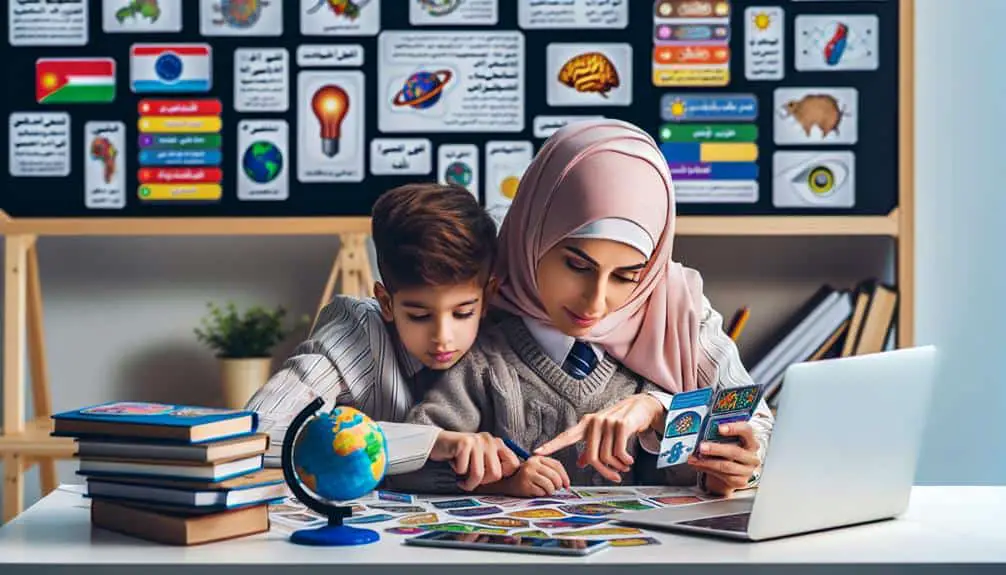To foster a growth mindset in homeschool education, consider different learning styles. Support visual learners with colorful visuals and encourage kinesthetic learners with hands-on activities. Tailor teaching approaches to each student, employing adaptive techniques and personalized feedback. Encourage exploration through hands-on projects and critical thinking. Embrace challenges and failures as learning opportunities, cultivating resilience. Create a crucial environment by acknowledging efforts and promoting collaboration. Cultivating a growth mindset in homeschooling is essential for academic success and personal growth. You can enhance your homeschooling journey by embracing these strategies.
Key Points
- Encourage embracing challenges and failures as opportunities for growth.
- Cultivate a positive learning environment through acknowledgment and praise.
- Provide hands-on activities and projects for active engagement.
- Foster resilience by reframing failures as valuable learning experiences.
- Support a growth mindset by creating a safe space for exploration and experimentation.
Understanding Different Learning Styles
To effectively cater to diverse learning preferences, it's essential for homeschool educators to comprehend the various learning styles their students may exhibit. Visual learners absorb information best through visual aids like charts, graphs, and diagrams. As a homeschool educator, you can support visual learners by incorporating colorful visuals into your lessons and encouraging them to create their own visual representations of the content.
On the other hand, kinesthetic learners thrive through hands-on activities and physical experiences. These students learn by doing and prefer activities that involve movement and interaction. To accommodate kinesthetic learners in your homeschool environment, consider incorporating experiments, role-playing exercises, or even outdoor learning opportunities where they can engage physically with the material.
Understanding the distinctions between visual and kinesthetic learners can help you tailor your teaching methods to better suit the diverse needs of your students. By recognizing and incorporating strategies that cater to different learning styles, you can create a more inclusive and effective learning environment for all your homeschool students.
Tailoring Teaching Approaches
Adapting your teaching approaches to align with the diverse learning styles of your homeschool students is essential for fostering an inclusive and effective educational environment. Individualized instruction tailored to each student's strengths, weaknesses, interests, and preferred learning methods can greatly enhance their academic growth and mindset development. By employing adaptive techniques, you can cater to visual, auditory, kinesthetic, and reading/writing learners more effectively.
When providing individualized instruction, consider conducting learning style assessments to identify how each student learns best. Some students may thrive through hands-on activities, while others may prefer visual aids or verbal explanations. By understanding these preferences, you can tailor your teaching methods to suit their needs and optimize their learning experience.
Furthermore, incorporating adaptive techniques such as flexible lesson plans, varied instructional approaches, and personalized feedback can help accommodate different learning styles within your homeschool environment. Being open to adjusting your teaching strategies based on students' responses and progress fosters a dynamic and engaging educational setting that nurtures growth mindset and academic success.
Encouraging Exploration and Experimentation
Tailoring teaching approaches to align with diverse learning styles in homeschool education sets the stage for encouraging exploration and experimentation among students. By incorporating hands-on activities and creative projects into your homeschool curriculum, you provide opportunities for students to engage actively with the material. These activities not only make learning fun and memorable but also foster critical thinking and problem-solving skills. Encouraging exploration through hands-on experiences allows students to apply theoretical knowledge to practical situations, enhancing their understanding of concepts.
Moreover, fostering experimentation in homeschool education involves creating a safe space for trial and error. Encourage your students to take risks, try new approaches, and learn from their mistakes. This approach nurtures a growth mindset by emphasizing the learning process rather than just the end result. Through experimentation, students develop resilience, perseverance, and a willingness to embrace challenges. By promoting a culture of exploration and experimentation in your homeschool environment, you empower students to become confident, independent learners who are unafraid to think outside the box.
Embracing Challenges and Failures
Encouraging students to embrace challenges and learn from failures is essential for fostering a growth mindset in homeschool education. Developing a resilience mindset is pivotal for students to navigate difficulties and setbacks effectively. When faced with challenges, students should be encouraged to see them as opportunities for growth rather than insurmountable obstacles. By reframing failures as learning experiences, students can cultivate a mindset that values effort and progress over perfection.
In homeschool settings, creating an environment where mistakes are viewed as part of the learning process can help students build resilience and perseverance. Encouraging students to reflect on their failures, identify areas for improvement, and try again fosters a growth mindset that values continuous learning and development. Embracing challenges not only promotes academic growth but also equips students with important life skills such as problem-solving and adaptability.
Cultivating a Positive Learning Environment
To cultivate a positive learning environment in homeschool education, fostering a mindset that embraces challenges and failures is essential. Vital reinforcement plays a crucial role in shaping this environment. Acknowledging efforts, progress, and achievements, no matter how small, helps instill confidence and motivation in learners. Encouraging words and gestures of praise can go a long way in nurturing a positive attitude towards learning.
In addition to vital reinforcement, engaging in collaborative activities can foster a sense of community and support among homeschool learners. Working together on projects, discussions, or problem-solving tasks not only enhances social skills but also promotes a positive learning atmosphere where students feel valued and connected.
Creating a space where mistakes are viewed as opportunities for growth and where support and encouragement are abundant is essential for cultivating a positive learning environment in homeschool education. By incorporating vital reinforcement and collaborative activities into your homeschool routine, you can help foster a mindset that embraces challenges and failures as stepping stones to success.




